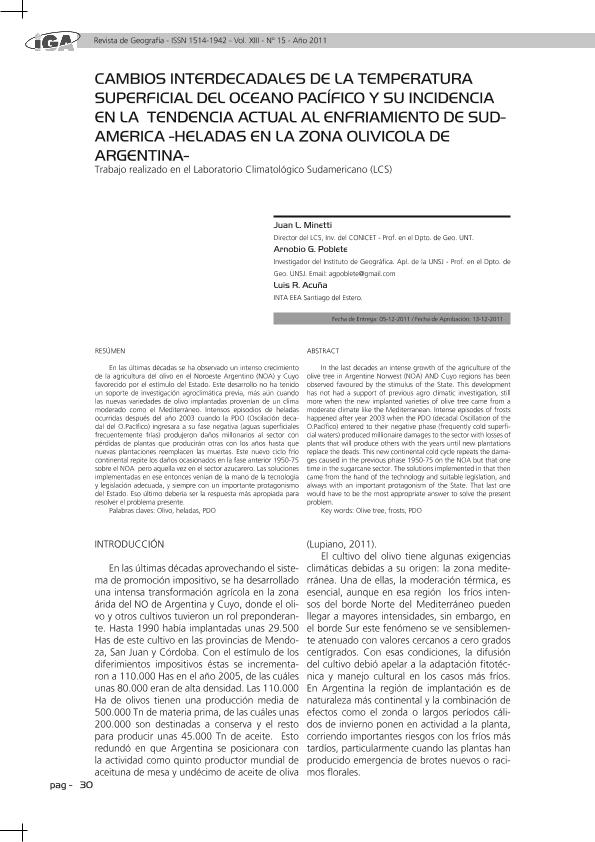Artículo
En las últimas décadas se ha observado un intenso crecimiento de la agricultura del olivo en el Noroeste Argentino (NOA) y Cuyo favorecido por el estímulo del Estado. Este desarrollo no ha tenido un soporte de investigación agroclimática previa, más aún cuando las nuevas variedades de olivo implantadas provenían de un clima moderado como el Mediterráneo. Intensos episodios de heladas ocurridas después del año 2003 cuando la PDO (Oscilación decadal del O.Pacífico) ingresara a su fase negativa (aguas superficiales frecuentemente frías) produjeron daños millonarios al sector con pérdidas de plantas que producirán otras con los años hasta que nuevas plantaciones reemplacen las muertas. Este nuevo ciclo frío continental repite los daños ocasionados en la fase anterior 1950-75 sobre el NOA pero aquella vez en el sector azucarero. Las soluciones implementadas en ese entonces venían de la mano de la tecnología y legislación adecuada, y siempre con un importante protagonismo del Estado. Eso último debería ser la respuesta más apropiada para resolver el problema presente. In the last decades an intense growth of the agriculture of the olive tree in Argentine Norwest (NOA) AND Cuyo regions has been observed favoured by the stimulus of the State. This development has not had a support of previous agro climatic investigation, still more when the new implanted varieties of olive tree came from a moderate climate like the Mediterranean. Intense episodes of frosts happened after year 2003 when the PDO (decadal Oscillation of the O.Pacífico) entered to their negative phase (frequently cold superficial waters) produced millionaire damages to the sector with losses of plants that will produce others with the years until new plantations replace the deads. This new continental cold cycle repeats the damages caused in the previous phase 1950-75 on the NOA but that one time in the sugarcane sector. The solutions implemented in that then came from the hand of the technology and suitable legislation, and always with an important protagonism of the State. That last one would have to be the most appropriate answer to solve the present problem.
Cambios interdecadales de la temperatura superficial del Oceáno Pacífico y su incidencia en la tendencia actual al enfriamiento de Sudamérica-Heladas en la zona olivícola Argentina
Título:
Superficial temperature changes between decades in the Pacific ocean and the incidence in the actual trend to the cooling in South America. Freezing climate at the olive oil Argentinian zone
Fecha de publicación:
12/2011
Editorial:
Universidad Nacional de San Juan. Facultad de Filosofia, Humanidades y Artes. Instituto de Geografía Aplicada
Revista:
Revista de Geografía
ISSN:
1519-4817
Idioma:
Español
Tipo de recurso:
Artículo publicado
Clasificación temática:
Resumen
Palabras clave:
Pdo
,
Heladas
,
Área Olivícola
,
Argentina
,
Olivo
,
Heladas
Archivos asociados
Licencia
Identificadores
Colecciones
Articulos(CCT - NOA SUR)
Articulos de CTRO.CIENTIFICO TECNOL.CONICET - NOA SUR
Articulos de CTRO.CIENTIFICO TECNOL.CONICET - NOA SUR
Citación
Minetti, Juan Leonidas; Poblete, Arnobio German; Acuña, Luis R.; Cambios interdecadales de la temperatura superficial del Oceáno Pacífico y su incidencia en la tendencia actual al enfriamiento de Sudamérica-Heladas en la zona olivícola Argentina; Universidad Nacional de San Juan. Facultad de Filosofia, Humanidades y Artes. Instituto de Geografía Aplicada; Revista de Geografía; XIII; 15; 12-2011; 30-34
Compartir




